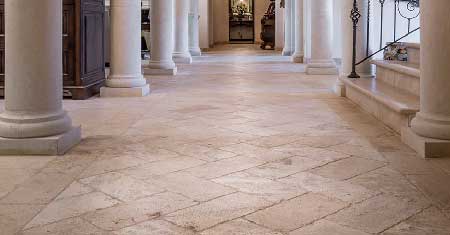
Travertine is a form of limestone often confused with marble. It is a natural stone formed from mineral layers in limestone caves or hot springs. It forms on land areas instead of underwater, and the mineral layers result from pressure and heat from the earth. Travertine, when used for flooring or countertop surfaces, is smoothed and polished to many types of finishes to enhance its look and durability. The stone has particular impurities that make it useful for both interior and exterior applications.
Travertine Features, Color, and Usage
Homeowners often use travertine for floor tiles, countertops, backsplashes, fireplaces, and wall cladding. We also often see it used in kitchens and bathrooms. Color availability options include gold, walnut, ivory, and beige. Its natural color tones derive from organic properties found in its minerals. It can feature a polished shine, tumbled, matte hone finish, and for textured surfaces, it may be brushed. These options determine the type of texture or gloss the stone will have based on use. It has a similar feel and touch as marble but has a more natural presentation while reflecting less light.
It is a popular stone to use for kitchen and bathroom projects because it offers a calm, natural appeal that complements other natural tones such as wood and modern designs. Property owners will find travertine durable and long-lasting with proper maintenance. As a soft stone with absorbent properties, a few coats of sealant prevent the stone from absorbing debris and stains. The sealant can be applied annually or whenever needed.
Additional Things to Know About Travertine
When making decisions to buy travertine, consider it’s intended location and use. The cost of travertine varies depending on the cut, quality, and square footage. It is affordable to purchase but quite heavy to move. Travertine has unique durability; we can still find ancient ruins made of travertine in existence today. Consider surface protection options; some stains may leave a mark, and certain chemicals will cause erosion and pitting. A quality sealant is necessary to prevent scratches and stains. A professional installer will provide additional guidance for maintenance and long-term care.

